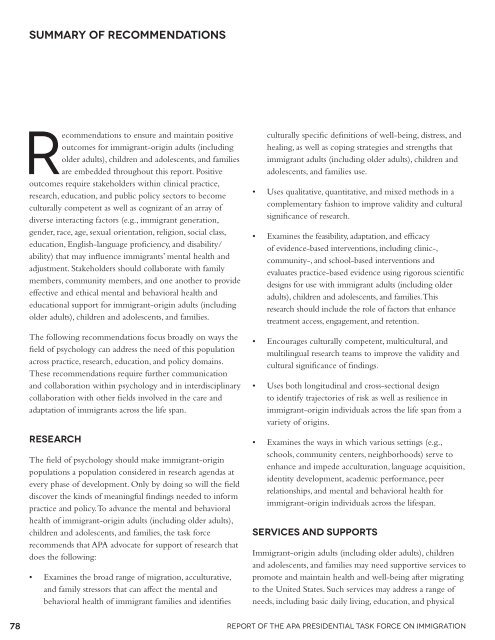Crossroads: The Psychology of Immigration in the New Century
Crossroads: The Psychology of Immigration in the New Century
Crossroads: The Psychology of Immigration in the New Century
You also want an ePaper? Increase the reach of your titles
YUMPU automatically turns print PDFs into web optimized ePapers that Google loves.
summary <strong>of</strong> recommendations<br />
Recommendations to ensure and ma<strong>in</strong>ta<strong>in</strong> positive<br />
outcomes for immigrant-orig<strong>in</strong> adults (<strong>in</strong>clud<strong>in</strong>g<br />
older adults), children and adolescents, and families<br />
are embedded throughout this report. Positive<br />
outcomes require stakeholders with<strong>in</strong> cl<strong>in</strong>ical practice,<br />
research, education, and public policy sectors to become<br />
culturally competent as well as cognizant <strong>of</strong> an array <strong>of</strong><br />
diverse <strong>in</strong>teract<strong>in</strong>g factors (e.g., immigrant generation,<br />
gender, race, age, sexual orientation, religion, social class,<br />
education, English-language pr<strong>of</strong>iciency, and disability/<br />
ability) that may <strong>in</strong>fluence immigrants’ mental health and<br />
adjustment. Stakeholders should collaborate with family<br />
members, community members, and one ano<strong>the</strong>r to provide<br />
effective and ethical mental and behavioral health and<br />
educational support for immigrant-orig<strong>in</strong> adults (<strong>in</strong>clud<strong>in</strong>g<br />
older adults), children and adolescents, and families.<br />
<strong>The</strong> follow<strong>in</strong>g recommendations focus broadly on ways <strong>the</strong><br />
field <strong>of</strong> psychology can address <strong>the</strong> need <strong>of</strong> this population<br />
across practice, research, education, and policy doma<strong>in</strong>s.<br />
<strong>The</strong>se recommendations require fur<strong>the</strong>r communication<br />
and collaboration with<strong>in</strong> psychology and <strong>in</strong> <strong>in</strong>terdiscipl<strong>in</strong>ary<br />
collaboration with o<strong>the</strong>r fields <strong>in</strong>volved <strong>in</strong> <strong>the</strong> care and<br />
adaptation <strong>of</strong> immigrants across <strong>the</strong> life span.<br />
research<br />
<strong>The</strong> field <strong>of</strong> psychology should make immigrant-orig<strong>in</strong><br />
populations a population considered <strong>in</strong> research agendas at<br />
every phase <strong>of</strong> development. Only by do<strong>in</strong>g so will <strong>the</strong> field<br />
discover <strong>the</strong> k<strong>in</strong>ds <strong>of</strong> mean<strong>in</strong>gful f<strong>in</strong>d<strong>in</strong>gs needed to <strong>in</strong>form<br />
practice and policy. To advance <strong>the</strong> mental and behavioral<br />
health <strong>of</strong> immigrant-orig<strong>in</strong> adults (<strong>in</strong>clud<strong>in</strong>g older adults),<br />
children and adolescents, and families, <strong>the</strong> task force<br />
recommends that APA advocate for support <strong>of</strong> research that<br />
does <strong>the</strong> follow<strong>in</strong>g:<br />
• Exam<strong>in</strong>es <strong>the</strong> broad range <strong>of</strong> migration, acculturative,<br />
and family stressors that can affect <strong>the</strong> mental and<br />
behavioral health <strong>of</strong> immigrant families and identifies<br />
culturally specific def<strong>in</strong>itions <strong>of</strong> well-be<strong>in</strong>g, distress, and<br />
heal<strong>in</strong>g, as well as cop<strong>in</strong>g strategies and strengths that<br />
immigrant adults (<strong>in</strong>clud<strong>in</strong>g older adults), children and<br />
adolescents, and families use.<br />
• Uses qualitative, quantitative, and mixed methods <strong>in</strong> a<br />
complementary fashion to improve validity and cultural<br />
significance <strong>of</strong> research.<br />
• Exam<strong>in</strong>es <strong>the</strong> feasibility, adaptation, and efficacy<br />
<strong>of</strong> evidence-based <strong>in</strong>terventions, <strong>in</strong>clud<strong>in</strong>g cl<strong>in</strong>ic-,<br />
community-, and school-based <strong>in</strong>terventions and<br />
evaluates practice-based evidence us<strong>in</strong>g rigorous scientific<br />
designs for use with immigrant adults (<strong>in</strong>clud<strong>in</strong>g older<br />
adults), children and adolescents, and families. This<br />
research should <strong>in</strong>clude <strong>the</strong> role <strong>of</strong> factors that enhance<br />
treatment access, engagement, and retention.<br />
• Encourages culturally competent, multicultural, and<br />
multil<strong>in</strong>gual research teams to improve <strong>the</strong> validity and<br />
cultural significance <strong>of</strong> f<strong>in</strong>d<strong>in</strong>gs.<br />
• Uses both longitud<strong>in</strong>al and cross-sectional design<br />
to identify trajectories <strong>of</strong> risk as well as resilience <strong>in</strong><br />
immigrant-orig<strong>in</strong> <strong>in</strong>dividuals across <strong>the</strong> life span from a<br />
variety <strong>of</strong> orig<strong>in</strong>s.<br />
• Exam<strong>in</strong>es <strong>the</strong> ways <strong>in</strong> which various sett<strong>in</strong>gs (e.g.,<br />
schools, community centers, neighborhoods) serve to<br />
enhance and impede acculturation, language acquisition,<br />
identity development, academic performance, peer<br />
relationships, and mental and behavioral health for<br />
immigrant-orig<strong>in</strong> <strong>in</strong>dividuals across <strong>the</strong> lifespan.<br />
services and supports<br />
Immigrant-orig<strong>in</strong> adults (<strong>in</strong>clud<strong>in</strong>g older adults), children<br />
and adolescents, and families may need supportive services to<br />
promote and ma<strong>in</strong>ta<strong>in</strong> health and well-be<strong>in</strong>g after migrat<strong>in</strong>g<br />
to <strong>the</strong> United States. Such services may address a range <strong>of</strong><br />
needs, <strong>in</strong>clud<strong>in</strong>g basic daily liv<strong>in</strong>g, education, and physical<br />
78 Report <strong>of</strong> <strong>the</strong> APA Presidential Task Force on <strong>Immigration</strong>
















